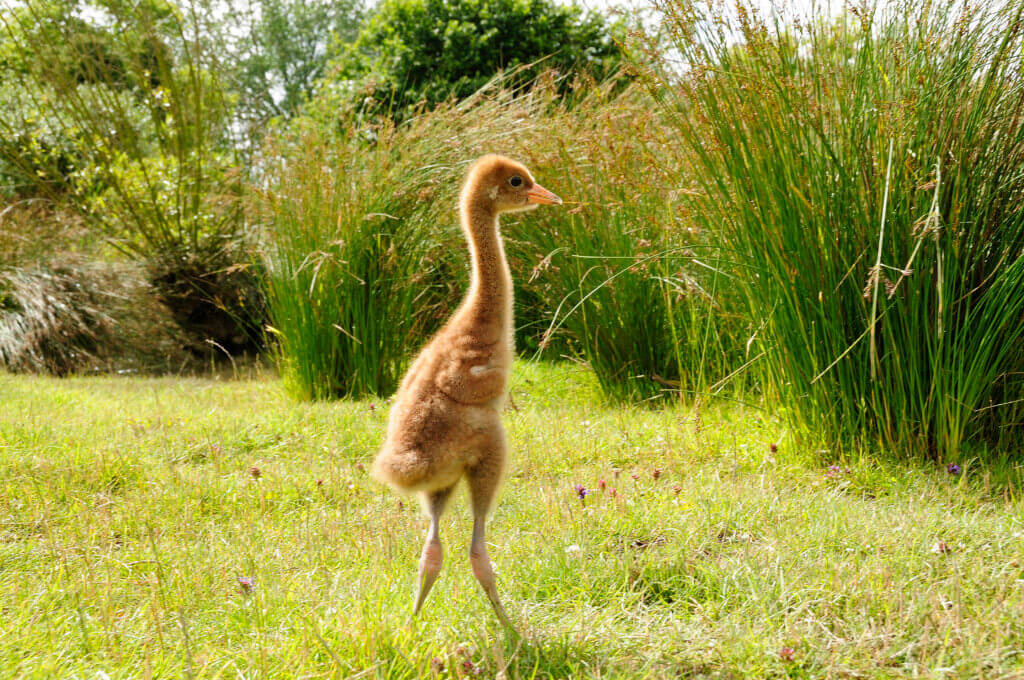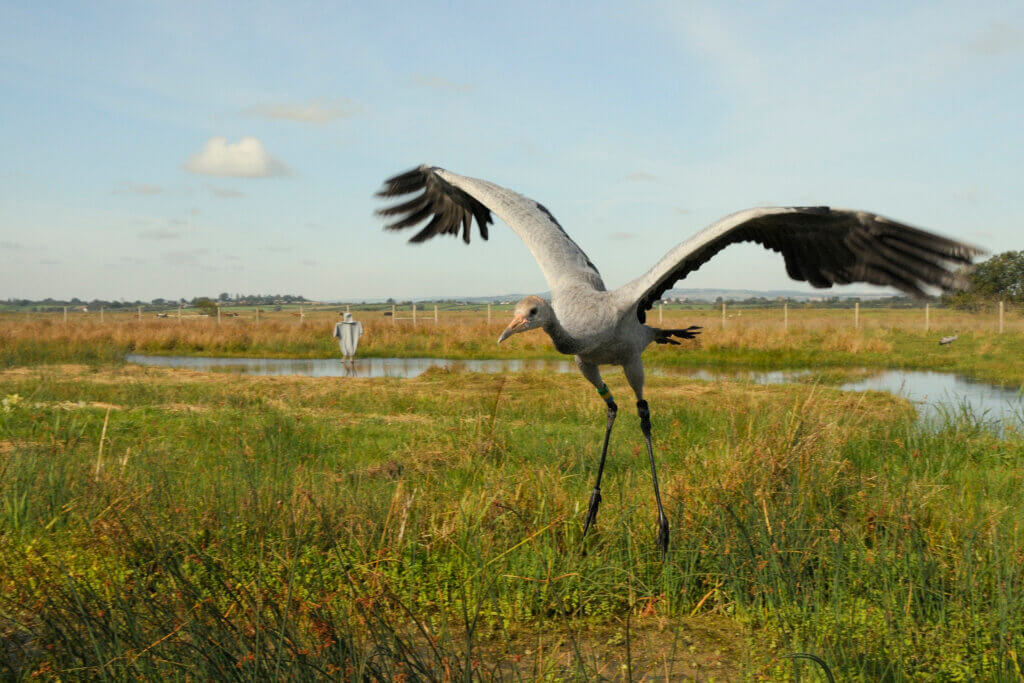UK Crane population reaches its highest level for over 400 years

- Latest common crane survey reveals a record-breaking 56 pairs of cranes in 2019, bringing the total population to an estimated 200 birds.
- Cranes became extinct in the UK around four hundred years ago but following the natural recolonisation of a few birds and extensive conservation work, including a reintroduction programme, these graceful birds are making a return.
- Cranes are the tallest bird in the UK, standing at 4ft. They are fabled for their dances; complex displays with bows, pirouettes and bobs, which take place every year between the male and female.
The crane was lost from the UK for nearly 400 years, but thanks to conservation efforts their population numbers have once again hit record levels.
These birds, the tallest in the UK at 4ft, used to be quite common. They were even frequent fixtures at medieval feasts – Henry II’s chefs cooked up 115 of them at his Christmas feast in 1251, but a combination of hunting and wetland decline led to their extinction in the 1600s.
In 1979, a small number of wild cranes returned to Norfolk and conservation groups have been working together to encourage more and more of these birds. They have now spread to other areas of the UK, benefitting from improved habitat such as at the RSPB’s Lakenheath and Nene Washes reserves as well as Natural England’s Humberhead Peatlands. Cranes recolonised Scotland in 2012 and Wales in 2016.
In 2010, the Great Crane Project – a partnership between the RSPB, WWT and the Pensthorpe Conservation Trust, and funded by Viridor Credits Environmental Company – joined the movement. The project creates and improves existing habitat, as well as hand-rearing young birds for release on the Somerset Levels and Moors.

All the conservation effort has yielded impressive results, with 56 pairs across the UK last year. Of these, up to 47 pairs attempted to breed and they raised 26 chicks. The total population is now believed to be over 200 birds – a new record.

Damon Bridge, Chair of the UK Crane Working Group said: “The increase of cranes over the last few years shows just how resilient nature can be when given the chance. With the support of our wonderful partners we’ve been able to recreate more and more of the cranes’ natural habitat, giving them a place to recuperate after the winter and raise their chicks. They are not yet out of the woods, but their continued population climb year after year is a very positive sign.”.
Andrew Stanbury, RSPB Conservation Scientist said: “Thanks to the dedication of individuals, the UK Crane Working Group and conservation organisations, we are delighted to see crane numbers continuing to recover. Nature reserves have played a vital role. At least 85% of the breeding population are found on protected sites, with a third on RSPB reserves alone.”.
Dr Geoff Hilton, WWT’s Head of Conservation Evidence said: “The reintroduction of lost species must be supported with good habitat management and protection for the recovery to work. The success of the crane project to date demonstrates what can be achieved in a short space of time by giving nature a helping hand. We also must thank dedicated land managers and farmers in the area for supporting crane conservation.”.
Chrissie Kelley, Pensthorpe Conservation Trust’s Head of Species Management said: “As partners in the GCP, and with a long association working with Eurasian Cranes, we are thrilled to see wild cranes doing so well. Seeing these birds in flight is breath-taking and we have regular sightings of them over our reserve in Norfolk. We hope soon to spot one of the released birds amongst those that visit Pensthorpe.”.
ENDS
[registration_form]
Are all the birds of natural origin or were there releases of imported birds?
Stuart – I think eggs were first imported from eastern Europe.
That’s correct. Between 2010 and 2014, 93 cranes were hatched from eggs brought from Germany and hand-reared before being released onto the Somerset Levels and Moors.
More info here:http://www.thegreatcraneproject.org.uk
Does it matter it is a restored native and we should all be glad of that surely.
The East Anglian birds are NOT from releases… the Norfolk population has been there for decades…. and there has probably been a bit of influx of mainland eurpean migrants staying around. In Cambs, we have 6 pairs at least, and ONE bird, Beatrice, made her own way from Somerset about 5 years ago… the rest are nothing to do with the release project, and this is true across eastern UK……..
Great news in these bleak times.
I saw my first Cranes on migration in north east Sweden, you hear the bugling calls first before seeing straggling lines of big elegant birds passing overhead. I’ve since seen them there several times autumn and spring. I’m less familiar with them in the UK although I’ve seen them several times, including a bird that spent nearly a year at Nosterfield NR and quarry. I have good friends who have been to Hornborgasjön – Västsverige and seen the great spectacle of thousands of spring passage Cranes, calling and dancing, I must go myself.
Wonderful birds, great to have them back in numbers. Can we have bigger wetlands please and Dalmatian Pelicans back too!
Paul, yes indeed. Many birders (and some conservationists) were quite sniffy about the Somerset Levels project but it’s wonderful to have cranes established there. I saw my first cranes at Horsey in the “top secret” days, when I was just getting back into birding – distant grey shapes in the mist which at first I mistook for sheep but a great thrill.
A good place to see them is at WWT Welney. We saw 26 there on a recent visit.
The East Anglian birds do indeed hang around the ouse washes including the Welney reserve in the winter, as long as the water levels allow, so a good time to see the flock (record last year 45…) but they disperse back to their breeding sites in late winter- March at the latest
I wonder if they will return to Cranstoun.
What is know of the “British” birds out with the breeding season……what are their movement, is there a migration?
The Non-Horsey East Anglian Birds gather near the Ouse washes. Norman Sills, ex of Lakenheath Fen, has become really expert at knowign each one – you can tell them all apart on the shade of grey, shape and colour of Bustle…. so we know that the Cambridgeshire, Lakenheath and other pairs gather to the Ouse washes, feeding on Maize stubble. They then start to disperse in February, back to breeding sites or, for young pairs are mooching around looking for a spot to breed in a year or two…. If the Ouse washes are too wet, they go Nene washes. Hoewever, the pairs on the Nene washes just stay there. The December roost can be a splendid thing
Thanks Louise
So when do farmers and the field sports lobby start campaigning to be allowed to cull them? I’m assuming, tomorrow?
The farmers near the washes are fine – they clear up the maize stubble. What they got annoyed with a couple of years ago was birders parking on roads and blocking minor roads……